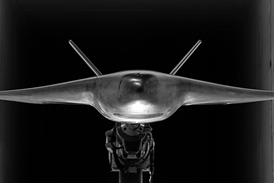STEWART PENNEY / LONDON
UK company's first airborne active electronically scanned array is aimed at helicopters, patrol aircraft and boats
BAE Systems Avionics intends to offer active electronically scanned array (AESA) technology upgrades for existing radars as well as new systems for a variety of platforms.
The company unveiled its first airborne AESA radar, the Seaspray 7000E for naval helicopters and small maritime patrol aircraft, at last month's Farnborough air show. BAE would deliver initial radars 18 months after receiving a contract.
Steve Marlow, BAE Avionics Sensor Systems division vice-president export naval helicopter systems, says the multimode Seaspray 7000E has been designed to fit the 255 x 685mm (10 x 27in) form of earlier Seasprays on the Westland Lynx and other helicopters, small fixed-wing maritime patrol aircraft, and boats. It also has a new open architecture processing system.
The Seaspray 7000E scans electronically in azimuth and elevation, and rotates to provide 360í coverage.
Marlow says the combination allows the radar to dwell on a target rather than waiting for the antenna to complete a revolution. The ability to point the beam improves modes such as inverse synthetic aperture radar, which requires a Doppler measurement between sensor and target.
Marlow says the radar weighs 25-30% less than comparable mechanical-scan radars while the transmit/receive modules (TRMs) use less power, allowing an increase in range or a reduction in power requirements for the same range.
Dr Paul Holbourn, BAE Avionics Sensor Systems division capability director, says the technology is "very scaleable, and can be applied to bigger or smaller radars. The TRMs are common building blocks." The antenna can be scaled by using fewer or more modules.
One potential target for the technology is the Blue Kestrel equipping the UK Royal Navy's AgustaWestland EH101-based Merlins.
Marlow says the technology is also suitable for upgrading existing Seasprays, either with the new processing system alone or with the antenna. Unmanned air vehicles are another target.
Holbourn says BAE has been working on active arrays since the early 1990s, but much of its focus has been on fast-jet radars. BAE says the Seaspray 7000E is the first AESA for a maritime helicopter radar.
Source: Flight International












































